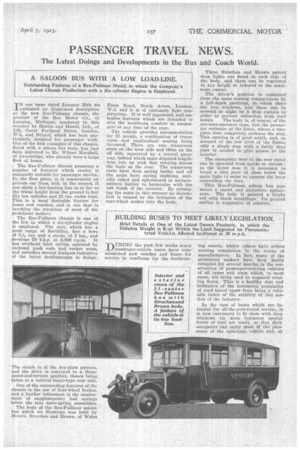13UILDING BUSES TO MEET LIKELY LEGISLATION.
Page 23

Page 24

If you've noticed an error in this article please click here to report it so we can fix it.
Brief Details of One of the Latest Dennis Products, in which the Unladen Weight is Kept Within the Limit Suggested for Pneumatic : tyTed Vehicks Allowed to..Travel at 20 m.p.h.
TIVRING the past few weeks many 1../passenger-vehiele users have commissioned new coaches and buses for service in readiness for the forthcom
lug season, whilst others have orders nearing completion in the works of manufacturers. In fact, many of the prominent makers have been busily occupied for several months in the construction of passenger-carrying vehicles of all types and sizes which, in most eases, are being used to augment existing fleets. This is a healthy sign and indicative of the increasing popularity of road travel apart from being a valuable index of the stability of this section of the industry.
In the case of buses which are intended for all-the-year-round service,., it is now customary to fit them with drop windows (in same instances special forms of roof are used), so that their occupants can enjoy most of the plea.sures of the open-type vehicle and, at
the same time, be afforded a measure of protection. This is true of the Dennis saloon bus illustrated on this page, which forms one of a number of iimilar vehicles now passing through the works of Dennis Brothers, Ltd., to the order of the Aldershot and District Traction Co., Ltd., who, it should be mentioned, already own a large fleet of single and double-decker vehicles of this make.
There are several features of outstanding interest in this vehicle, One of which, although of unquestionable importance at any time, is likely to play an even bigger part in the future advancement of the passenger-vehicle influstry, particularly if the recommendations of the Departmental Committee set up by the Ministry of Transport are adopted as the basis of new legislation. It may be remembered that, in its second interim report, this committee put forward the proposal that a vehicle, the total unladen weight of which does not exceed 3 tons 15 cwt., Should be permitted, if shod with pneumatic tyres, to travel at a maximum speed of 20 m.p.h.
The Dennis bus which we are about to describe briefly falls within this catetory, for its chassis weighs but 2 tons 8 cwt., and the 30-seater body with ;which it is fitted is so constructed that the total weight is kept within the suggested limit.
The chassis is, as a matter of fact, the company's new model, with a 15-ft. wheelbase, and provision is made for either the 30-40 h.p. engine, with a bore of 105 mm, and a stroke of 150 mm., or the 40-50 h.p. engine, with a bore of 115 mm. and a similar stroke to the smaller unit, to be fitted. If be larger power unit be favoured a small extra cost is involved.
The chassis has been primarily designed to run on pneumatic tyres, but solids can be fitted if preferred, and if tyres of the same dimensions be used on all wheels, a special dropped front axle is embodied in order to maintain a level load-line.
The type of body favoured on the .Aldershot bus is that in which the driver is accommodated in the body proper, but screened off in a separate compartment which extends half-way across the full width of the vehicle. By this arrangement it is possible to provide the maximum seating capacity. That section of the body on the near side of the driver's cab is provided with a longitudinal seat, but the remaining seats are arranged in the orthodox fashioni.e., transversely, with a central gangway between them.
The passenger entrance is at the rear, and, being inset as it is, the steps are kept within the overall width of the body. The steps, by the way, are illuminated at night by an electric light suitably disposed ; four other lamps provide adequate lighting for the interior.
This type of' bus is likely to prove as popular in summer as in winter, for proper attention has been given to passengers' requirements during the better months of the year, the windows on each side being arranged to be completely lowered or regulated at any given height. There is also a detachable pane of glass in the front of the bus, whilst the driver's compartment has a folding windscreen, but no light is fitted above the door panel, so that the driver is not C20 hampered in his desire to signal his intentions to other road users.
The general finish of the Aldershot bus is moil tasteful. The groundwork is of olive green, lined out in white with the company's title neatly inscribed in gold. So far as interior finish is concerned, the upper half of the body is painted white, that below the waist rail being in the natural wood. A tapered bonnet adds to the pleasing appearance of the vehicle, which is also enhanced by the large pneumatic tyres, the dimensions of which are 36 ins. by 6 ins, on the front wheels and 40 ins. by 8 ins, on those at the rear.




























